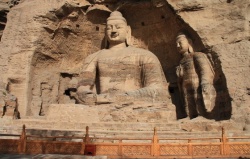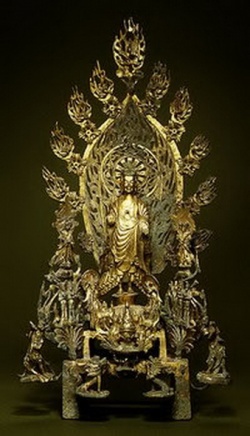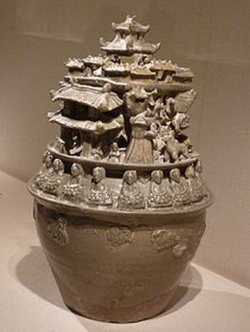Monasteries of the Jonang Sect in Golog
An investigation of Golog revealed that seven monasteries of the Jonang Sect have survived centuries of changes. The investigation, conducted in the summer of 1998, lasted for 50 days. When Lama Qoiboin had completed his study in the Gartu Monastery in Garze, Sichuan Province, he built the first monastery of the Nyingma Sect in Golog in 1493. Residents had previously worshiped the Bon religion. Lamas with the Garma Gagyu, Jonang and Gelug Sects followed suit in building their own monasteries here.
The Nyingma Sect was the first to build its monastery in Golog (in 1493). It was followed by the Garma Gagyu Sect in 1632, the Jonang Sect in 1716, and the Gelug Sect in 1812. In Golog, we found 39 monasteries belonging to the Nyingma Sect, seven to the Jonang Sect, five to the Gelug Sect, and one to the Garma Sect. The following are the seven monasteries that belong to the Jonang Sect.
Ashi Gyiangyia Gongba. It is also called Yaritang Monastery, with the Buddhist name of Dor'oxoizhuling.. Located in Jiefang Village, Jamritang Township, Baima County, it is about 10 km from the county seat and skirted by a highway. The Jamritang Monastery of the Nyingma Sect is its neighbor. Originally, the monastery was located in Zhigegor southeast of Yartang and was called Zhigegor Monastery belonging to the Nyingma Sect. It was the first Tibetan Buddhist monastery in the Tibetan-inhabited area in Golog. In the 18th century, the monastery's chief abbot went to study sutras in the Gartu Monastery, the then chief monastery of the Nyingma Sect. Others who studied together with him were given Buddhist hats, Clothes and objects, but he was bestowed with knives and other accoutrements used by lay people. He was not happy with this. On his way back to the Zhigegor Monastery, he came across Ngwang Dainzin Namgyai, the 32nd-generation master of the Jonang Sect. After a long talk, he decided to turn over the Zhigegor Monastery to the Jonang Sect. A new monastery was then built to be under the Tsangwo Monastery in Nangtang. The monastery originally had three Sutra halls, 31 Monk dormitories, four dagobas, which were dismantled in 1958 or thereafter. After 1984, one Sutra hall, one Buddha hall, and 20 Monk dormitories were built; the three ancient dagobas were rebuilt, and a new one added. Now, the monastery has over 60 monks, with some 30 resident monks. Most are from Jiefang Village.
Jianmoda Monastery. Located on the slope of the Yamrixumo Mountain in the Jianmo River Valley, Sogrima Township, 87 km west of Chorzhi County's Zhiqensomdor Township, it has the Zamda River to the left and Jianmo River in front. Built in 1849, the monastery has one Sutra hall, one mediation hall, and 20 Monk dormitories. It has a Monk population of 200, including 100 resident monks. Most came from Chagor and Angorli Tribes in the locality.
Langboin Monastery. Its Buddhist name is Dor'oxoizhuling. Located 10 km west of the Baima County, it is part of Langboin Village, Moba Township. It was built in 1943 by Oquehe, a Sichuan Nangtang Monk, and was attached to the Tsangwa Monastery. Now, it has 30 Monk dormitories, one Sutra hall and one white dagoba. It has a Monk population of 70, including 30 resident. Most of the monks came from Langboin Village; with others from Namda Village in Aba, Sichuan.
Nyingyor Monastery. Located in Nyingyor on the eastern bank of Shake River in Kangse Township, seven km south of Chorzhi County's Zhiqensomdor Township, the monastery features the coexistence of the Gelug and Jonang Sects. Monks hold common rituals during religious events. The monastery has two Sutra halls and three corridors for ritual walks, plus 75 Monk rooms. It has a Monk population of 60, mostly of the Gelug Sect. Most of the monks came from Masei Township.
Lhunshigyia Monastery. The monastery is located in the Tulanmo Gully by the Dongke River, Shiagongma Township, which is 10 km away from the Gande County seat. It is attached to the Tsangmotang Monastery in Nangtang County, Sichuan Province. Built by Gyialama some 100 years ago in the latter days of the Qing Dynasty (1644-1911), the Lhunshigyia Monastery now boasts one Sutra hall, tents serving as Monk dormitories, and one dagoba, and has a Monk population of 65-70. Most of people coming to worship are from tribes within the county.
Zhaxiqoilang Monastery. Sitting by the Xike Qu River in east Gande County, the monastery derives its name from the area in which it is located-Zhaxiqulang. Some 75 km away from the county seat, it is affiliated to the Tsangmotang Monastery in Nangtang County, Sichuan Province. It boasts 21 tent houses, one adobe Sutra hall, and four Monk dormitories, and has a Monk population of 64. Most of the worshippers come from a local tribe.
Chayilung Monastery. Located in Chayilung opposite to the Xike Qu River in Qenzin Township, which is 45 km northwest of Gande County. It was first a tent monastery, affiliated to the Lhunshigyia Monastery. In 1981, it underwent reconstruction complete with one adobe Sutra hall and five Monk dorms. Now it has a Monk population of 25.
Jianmoda Monastery
Of the seven monasteries, the Ashi Gyiangyia Gongba Monastery is the oldest, and hence is held as the number one of the Tsangwa Monastery system. Among the six built later, Jianmoda Monastery ultimately became the most influential.
Religious Activities. The monastery holds religious activities almost every month.
First Tibetan Month: Worshipping Kalachakra painted on a piece of cloth and Chanting the Time-Wheel Sutra for 15 days; Third Tibetan Month: Marking Dornornata's Death anniversary; Fourth Tibetan Month: Time-wheel rituals lasting 40 days. During this period, the Time-Wheel Sutra is chanted; Fifth Tibetan Month: Burning aromatic holy plants for auspicious smoke to mark the Death anniversary of Lama Huasang. Time-Wheel Sutra is chanted; Sixth Tibetan Month: Summer mediation from 15th to the 29th days; Eighth Tibetan Month: Holiday for all monks except for Jorzhuwa, who have to study Tantric doctrines; Ninth Tibetan Month: Studying; Tenth Tibetan Month: marking the Death anniversary of Genqen Jiboba; Eleventh Tibetan Month: Chanting peace-for-all sutras for 15-20 days, including the All-Embracing Heart Sutra and Tara Sutra; Twelfth Tibetan Month: Seven days of tributes to the Diamond-King With a Horse Head.
Taboos. These include: killing, showing disrespect to The Buddha, fighting, Gambling, theft, smoking or drinking, playing of billiards, watching videotapes, playing on game machines, and riding a motorcycle.
Monastic Study. The monastery is complete with mediation class, lecturing class, and school. Monks who first enter the monastery are required to learn to read and write Tibetan, study worship rituals, and master the skill of making butter sculptures. Gradually, they will be made to recite such sutras as the Avalokitesvara Six-Syllable Prayer, Conversion to Buddhism, and Tara Sutra, which are comparatively short. In the Lecturing class, the masters explain the key to some major sutras before concentrating on the study of the Collected Works by Manmo Ranwa Tubdain Geleg Gyamco and the practice of Kalachakra of the Jonang Sect. This is followed by study in the Mediation Class, where masters coach them to practice Yoga. This lasts for three years. Those completing the study are called Zhawa (monastic monks). Those who complete all studies in the monastery are qualified to perform abhiseka rituals in the capacity of Lama.
Jonang Sect of Tibetan Buddhism
In 1293, Kunboin Tugyi Zunzui (1243-1313), a fifth-generation disciple of Yumo Mijor Dorje (early 12th century), built the Jonang Monastery close to the Namangyiamo Mountain in Lhaze County, Xigaze Prefecture. Traditionally, the Namangyiamo Mountain is one of the Qomolangmo Mountain Gods.
The Jonang Sect reached its heyday during the Jibopa period (1290-1361), when many who had worshipped the Nyingma, Sagya and Gagyu Sects becoming converts. From the late 16th century to the early 17th century, with support from Dishi Tsangpa and under the strong influence of Dornornata (1575-1634), the Jonang Sect flourished. In 1614, Dornornata had the Dadan Danqoiling Monastery built as the main base for the Jonang Sect. Before long, Dornornata went to Outer Mongolia, where he lectured on Buddhist Doctrine for 20 years in Kulun (present-day Ulan Bator). The Jornang Sect believed everything was paramount in nature and would never change. It encouraged long-period mediation. As the theory challenged the tenets of the Gelug and other Tibetan Buddhist sects, it was treated as Heresy.
In 1434, Dornornata passed away in Outer Mongolia. When the wife of a Gorka tribe gave birth to a boy the following year, many held that he was the incarnation of Dornornata. The boy went to study in Tibet, returning to Outer Mongolia in 1649 when the 5th Dalai Lama was already in Power in Lhasa. As the Dalai Lama hated the Jonang Sect, he ordered the incarnate of Dornornata to convert to the Gelug Sect otherwise his religious position in Outer Mongolia would be refuted. Having no way out, the boy acquiesced and Outer Mongolia accepted the Doctrine of the Gelug Sect.
At the same time, the 5th Dalai Lama confiscated all Sutra Books and Sutra printing boards belonging to the Jonang Sect, except for the History of Indian Buddhism produced by Dornornata. The Dadan Danqoiling Monastery was renamed Gardain Puncoling belonging to the Gelug Sect.
Historians hold that the Jonang Sect no longer existed in the late 17th century. However, its influence in U-Tsang is still felt. In Golog, there are seven monasteries adhering to it.



